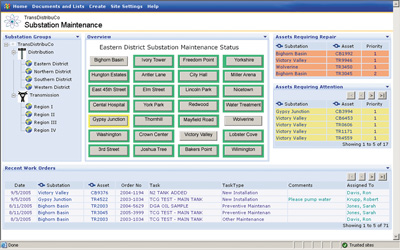

Every company is dependent on some type of asset that keeps the business in business – be it a computer, a centrifuge, or a power transformer. In a large enterprise, reducing costs related to asset maintenance, repair, and ultimate replacement is at the top of management concerns. Downtime in any network, manufacturing, or computer system ultimately results not only in high repair costs, but in customer dissatisfaction and lower revenues. Real-time Condition-based Maintenance (CBM) provides a unique solution to the age old question—how to better plan and monitor critical maintenance processes and assets.
Reliability and uninterrupted service to customers are the goals of any T&D organization, but keeping systems up and running is no small task. Electricity must be produced, transmitted and distributed – almost instantaneously – to the point of consumer consumption.
Imagine a typical transmission scenario where a circuit breaker trips.The first action the operator will take is to close the breaker. The breaker trips again. Suspecting contact chatter, the operator attempts to close it again. Testing into a fault – open, close, open, close – is very stressful on a breaker.
What if that operator had all the historical data – past wear and tear, operating history, past failures – as well as real-time data about that piece of equipment? In this case, data about the asset can translate to improved decision making. If he had that information at his fingertips, he could take action with more confidence, while eliminating the stress that blind trial and error puts on equipment.
Multiply this by hundreds of such situations occurring with remote assets on a daily basis and you’ve got a problem: a hit to your bottom line. Change the approach by bringing consistent, real-time data to your operations, and you’ve just positively impacted your reliability and productivity.
Companies using real-time data in their SCADA and EMS systems are just scratching the surface of the amounts of data available to them. Today, only 10% of all operational data is collected (but not always stored permanently) through real-time control systems. The remaining 90% comprises data that is not being used to its full advantage.

By gathering all dynamic data in one repository, then monitoring and analyzing data from the perspectives of both operations and engineering, utilities can transform this wealth of data into actionable information, directly affecting bottom-line measures like efficiency and productivity.
Out with the old
Unplanned downtime can be costly and highly disruptive if not managed properly. Due to the highly integrated nature of modern power systems in North America, local disturbances can have a widespread impact on reliability.
In a move to more effectively manage assets and integrate real-time data into viable processes, utilities must take into consideration the combination of an aging infrastructure and a workforce with a diminishing availability of technical experience and subject matter expertise.
While utilities are jumping through hoops to get rate cases through their PUCs to support massive infrastructure improvements and lobbying Congress for the same, real-time enterprise historians can ensure that costly old assets, like transformers, will run for a longer period of time, and safely.
Additionally, as the age profile of the workforce changes, utilities need to maximize the use of their real-time data, which provides the mechanism for capturing “tribal knowledge” and applying it throughout the organization.
The Competitive Edge…with Condition-Based Maintenance (CBM)
How do utilities keep their edge and run traditional regulated business in today’s more competitive market? The answer is by reducing maintenance costs and managing investments and assets more strategically.
Maintenance processes and systems have evolved dramatically over the years. In the early years, maintenance consisted of reacting to mechanical breakdowns. As technology progressed, the solution gradually evolved from a time-based model to a condition-based one.
Today, effective maintenance systems are expected to detect early forms of degradation in predictive maintenance practices in tandem with CBM.
Predictive maintenance defines methods to predict or diagnose problems in a piece of equipment based on trending of test results. These methods use non-intrusive testing techniques to measure and compute equipment performance trends.
CBM is a methodology that combines predictive and preventive maintenance with real-time monitoring. CBM systems detect fault sources well in advance of failure, making maintenance a proactive process.
CBM accurately detects the current state of mechanical systems and predicts the systems’ ability to perform without failure. It uses the stressor levels created during the machinery design process, measures suitable parameters to quantify the existing stressor levels, and corrects operating environments to make these levels compatible with economic production versus equipment lifetimes.
Improving Asset Management with CBM
CBM adds two important dimensions to classical predictive maintenance solutions.
First, CBM looks at the entire system and all of its assets. This holistic approach to maintenance represents a major shift from the fragmented technologies of the past. While CBM can be implemented in single steps, its greatest potential is realized when it is applied consistently and evenly across an entire asset class, employing the full range of maintenance concepts.

The second added dimension is the concept of extending maintenance intervals. CBM replaces arbitrarily timed maintenance with scheduled maintenance warranted by the equipment condition. It advocates the analysis of equipment condition data to allow planning and scheduling of maintenance activities or repairs before functional failure.
Comprehensive use of data across the organization can help organizations prevent disruptions. The critical piece is data: a combination of real-time, on-demand data, in addition to the less time-sensitive information. By automatically analyzing data before disseminating it to all responsible parties, utilities will turn the mounds of data into actionable information.

With this information, organizations can take preventative steps and prioritize action with confidence, while concurrently capturing utility “tribal knowledge” in the form of abstracted algorithms, analyses and business rules so that this information can be applied to similar classes of utility assets or networks.
With CBM, organizations perform maintenance only when needed to prevent operational deficiencies or failures, to eliminate costly periodic maintenance, and to significantly reduce the likelihood of mechanical failures.
Today, a proactive approach that can identify and act on maintenance problems makes good business sense.
As manufacturing and utility companies become more competitive in a global market, increased availability becomes an issue. Companies need to run traditional regulated businesses competitively, reduce maintenance costs, and manage investment and assets strategically and efficiently.
Likewise, in an unregulated market, customer service and resulting customer satisfaction are essential.Utility companies strive to maximize performance at the lowest lifecycle cost, while improving system reliability by eliminating catastrophic equipment failures.CBM strives to identify incipient faults before they become critical.
CBM – Your Implementation Guide
By putting valuable information – such as analytics, notifications and event alerts, and intuitive visualizations – around real-time data, utilities can address a myriad of challenges from the aging workforce, proactive management of an increasing number of assets, and the growing compliance demands.
Providing access to mounds of operational data in and of itself does not guarantee that an operator or engineer will detect the underlying event or emerging condition.A CBM approach depends upon:
• Being able to easily configure the calculation or notification that will prompt operators or engineers into action;
• Real-time trending combined with analytics to apply intelligence to make the data actionable, to spot trends and system anomalies (this is central to the effective management of assets, especially those that are remote or highly distributed);
• On-demand visualization and alerting, which is imperative for success – the visualization must be intuitive, crisp, and easily navigable.
Utilities must formulate a long range strategy to replace – on a proactive and risk-adjusted basis – the aging transmission line and T&D substation infrastructure to improve reliability and control equipment operation and maintenance costs. They must also develop a spending plan to support replacement of aging infrastructure, including provisions for adequate spares and inventory.

By moving away from the confines of a calendar-based maintenance and towards more dynamic asset management, utilities will better predict equipment failures before they occur, minimizing costly failures, automatically triggering maintenance tasks and extending the life of aging equipment through more efficient performance monitoring.

(You can get a bigger picture here. )
______________________
Tip List:
Collecting and Modeling Data for Condition-Based Maintenance
The CBM methodology involves the following steps:
1. Collect all relevant data needed to monitor and analyze all maintenance units, systems, and devices and ensure that it can be accessed in real-time.
2. Structure the real-time data for calculations, computation, analysis, visualization, service-reuse, and scalability.
3. Create a portal site to visualize the real-time data, to create reports, and to report and act on problems as they occur or alarm/alert and early warning.
Tip List: Your CBM Technology Checklist
The best source of aggregating and analyzing real-time data for a condition-based maintenance strategy is an enterprise-class data historian. Be sure to consider the following, critical factors when integrating a new technology solution:
• Integration with legacy environments that allows users to access data from older systems in order to extend the life of operational assets
• Configurable analytics and notification support
• Ability to implement a ‘Manage by Exception’ management framework, which is the foundation on which CBM is built
• Ability to support extremely large volumes of dynamic data with original fidelity and high performance
• Intuitive, powerful visualization, including high fidelity, real-time trending, prioritization of KPIs
______________________
Trust your data for improved confidence in decision making It’s time to raise the expectation of what utilities can control and what they can deliver. With strategic CBM best practices in place, interrupted service can be avoided and downtime can be better managed.
As technology improves, data frequency will grow exponentially, and utilities will demand an infrastructure that can handle it. As you head down the path to preparing for the Intelligent Grid and Automatic Metering Infrastructure (AMI), consider that real benefits will come from combining and reconciling new sources, such as AMI data (usage and event data), with operational data from SCADA and other sources.
This will provide real-time visibility downstream of the breaker and enable real-time – or in some cases, near real-time – operational capabilities, including:
– Dispatch of load for grid management
– Management of distributed energy resources
– Situational data in near real-time
– Outage & service condition information at the customer level
– Support rate option innovations
Utilities need data that delivers trusted results – data that can be reconciled, be combined with distribution automation and AMI meter reads and provide audit trails.
An enterprise-class data historian will distribute intelligent information to people and systems, such as distribution engineers, operators, outage management systems (OMS) and circuit analysis tools. Ultimately, it will enable the intelligent grid, in which the grid automatically “heals itself” as a result of effective analysis, notification systems and visualization of real-time data.
By allowing technology to work for you, your T&D organization will be able to efficiently collect data and provide a means for advanced analysis, creating an environment where all levels of the organization will be better informed about the health of critical equipment. And with this level of understanding, confidence and visibility into the operations, your organization will realize immediate benefits, which only increase over time.
About the Authors
Debra Henderson
Business Development Executive, OSIsoft Debra Henderson is a 26-year veteran of the energy industry, primarily in transmission and distribution operations and engineering. Debra’s employment experience includes PG&E Corporation, CellNet Data Systems, Silicon Energy and Itron.She holds a degree in electrical engineering from California Polytechnic University, San Luis Obispo and an MBA from California State University, East Bay. She is a registered electrical engineer in California.
Ann Moore
Business Development Executive, OSIsoft Ann Moore joined OSIsoft last year as a Business Development Executive, focusing on expanding OSIsoft’s business in China. Prior to this she had worked for San Diego Gas & Electric for 17 years. She was in charge of the software development and support for SDG&E’s Grid Operations real-time control Energy Management System (EMS). In this capacity, she also managed all EMS system-related projects, including PI. She graduated from the University of Michigan-Ann Arbor, with an MS degree in Computer Engineering.







